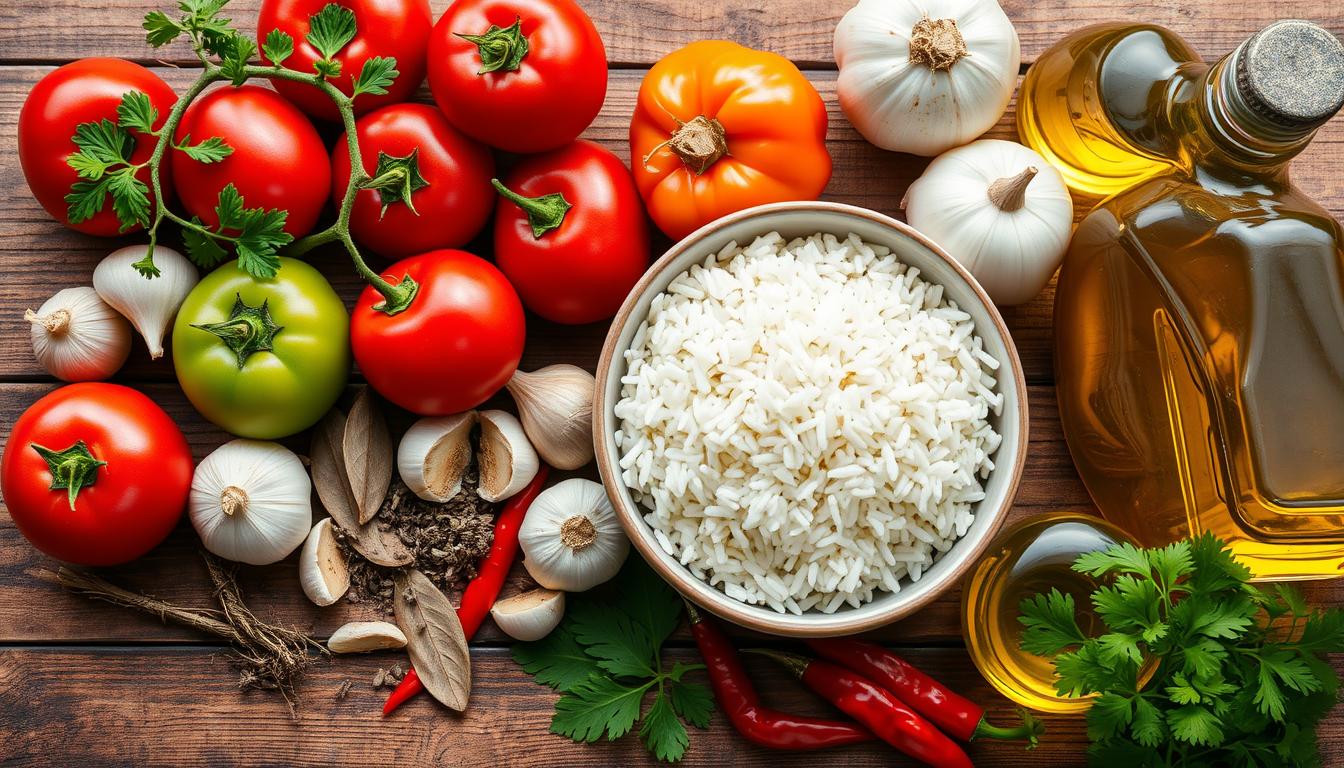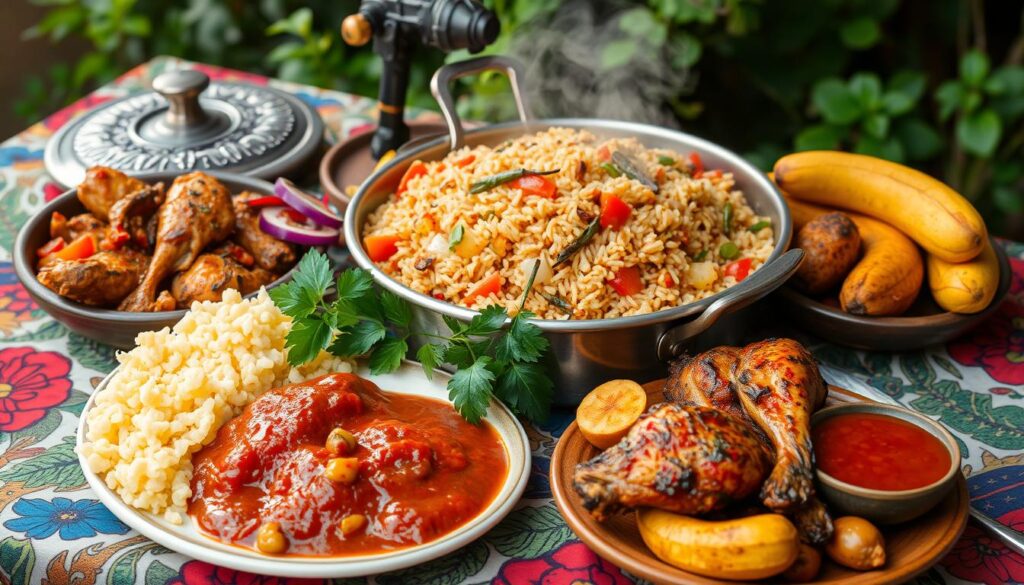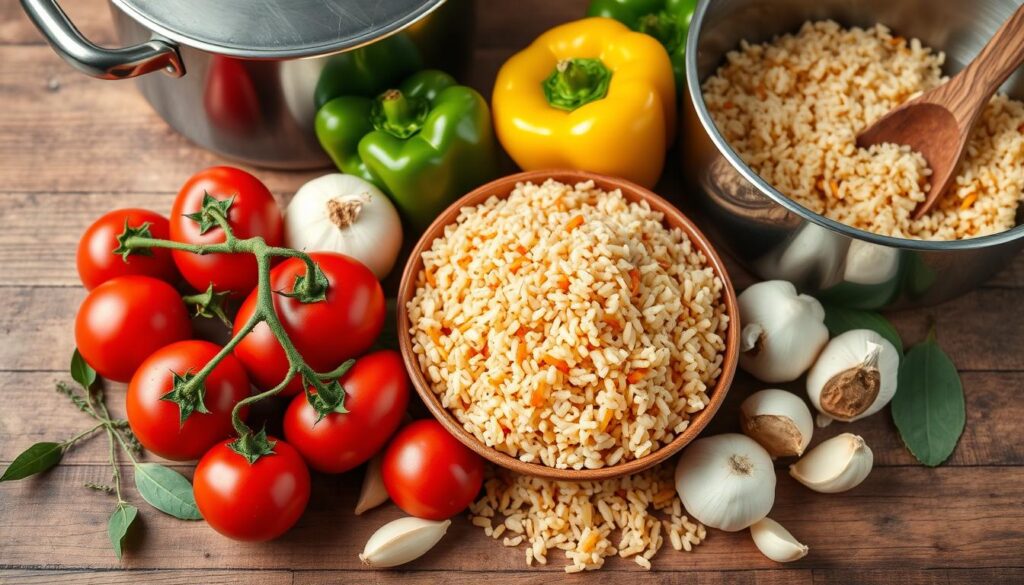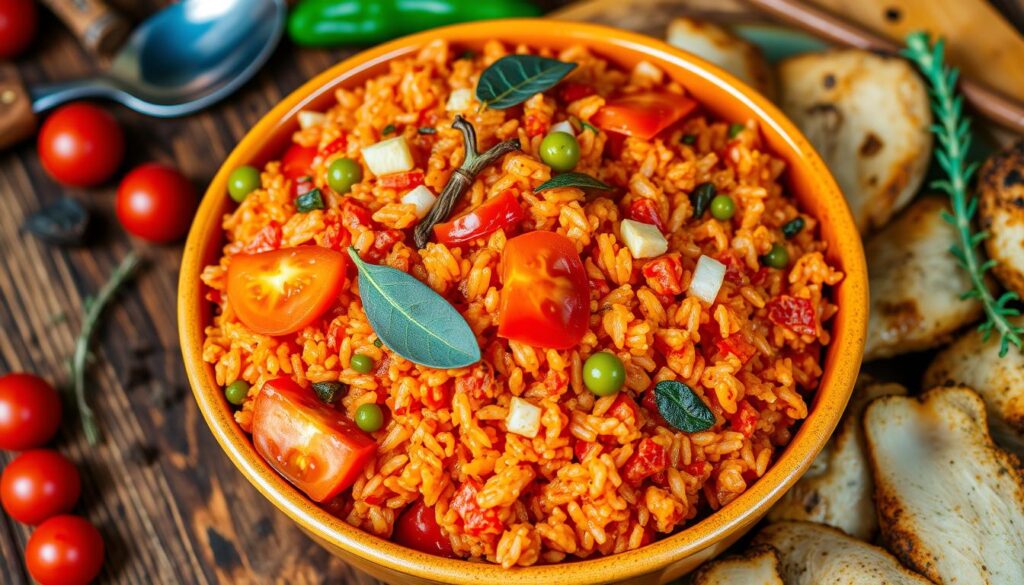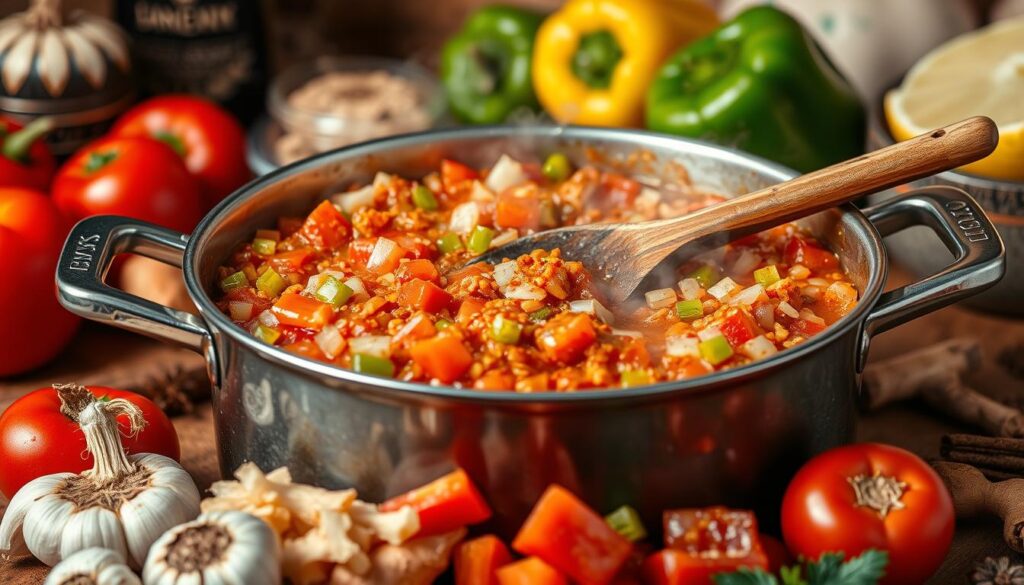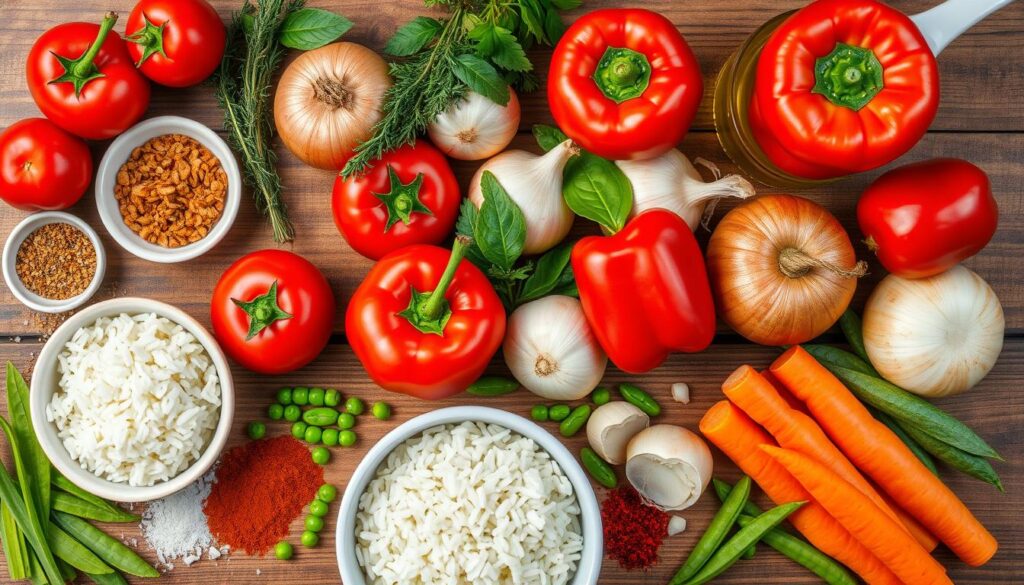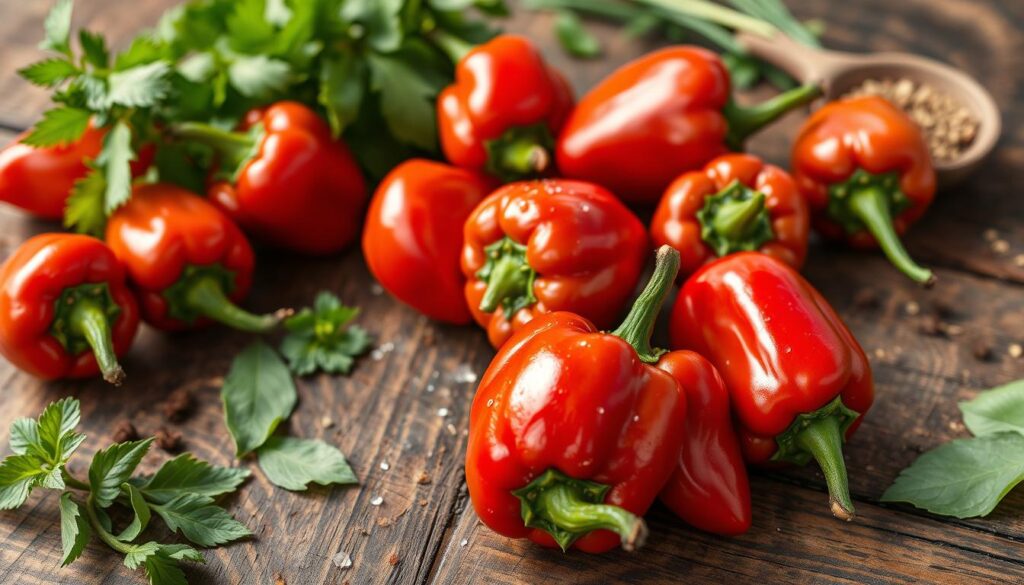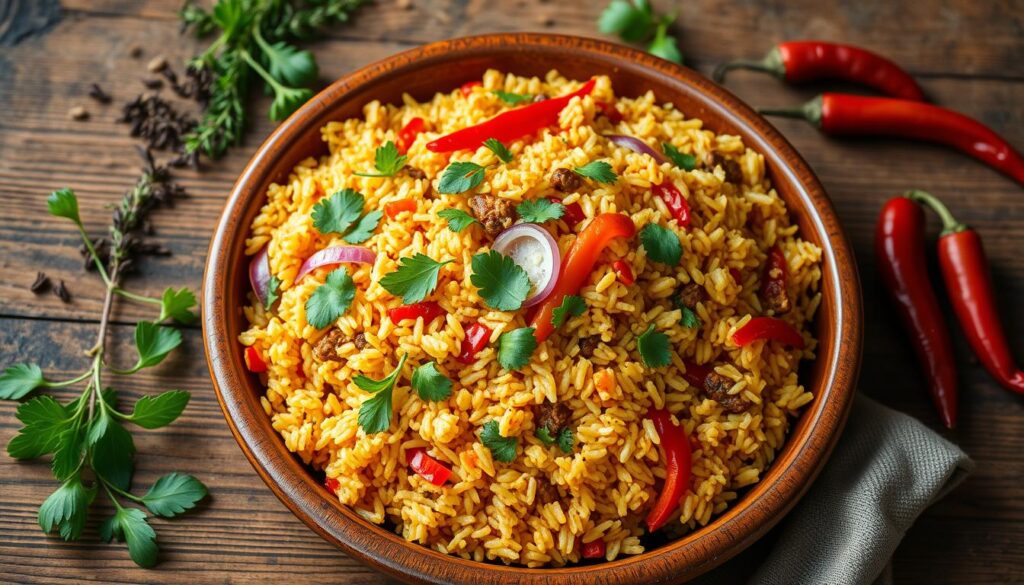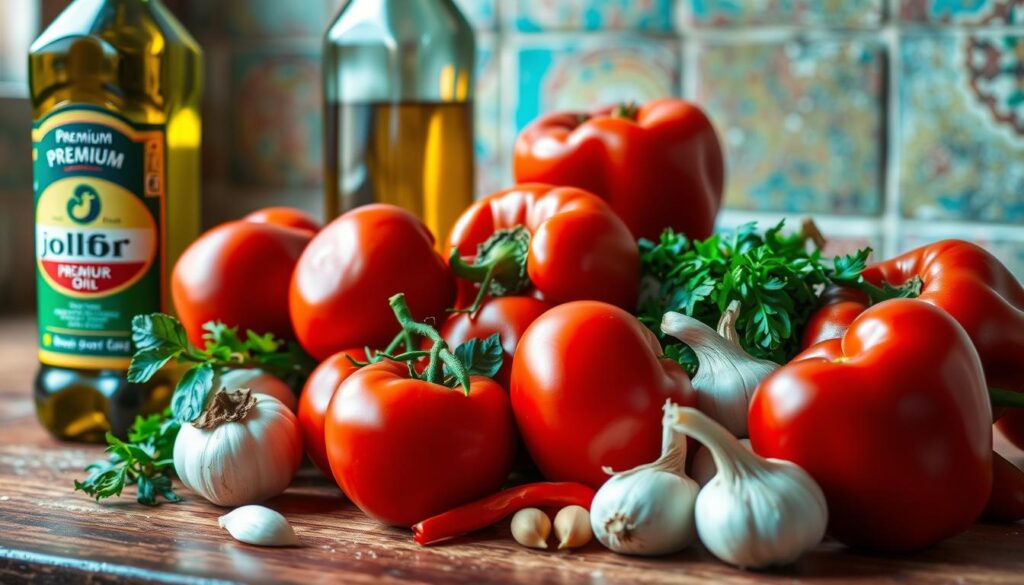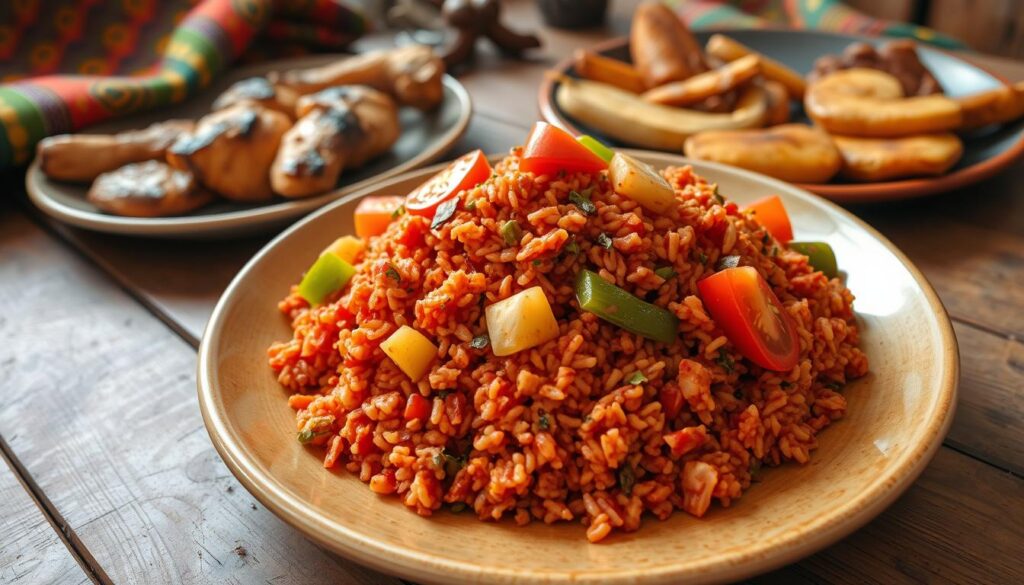Jollof rice is a favorite in West Africa, loved in places like Nigeria, Ghana, Senegal, and Gambia. It’s a one-pot dish known for its deep, spicy taste. It mixes rice, tomatoes, onions, peppers, and special African spices.
This dish is a big hit at special times, like holidays and celebrations. It’s a key part of West African culture and traditions.
Key Takeaways
- Jollof rice is a staple dish in West African cuisine, especially in countries like Nigeria, Ghana, Senegal, and Gambia.
- The main ingredients for jollof rice include rice, tomatoes, bell peppers, scotch bonnet, onions, garlic, and ginger.
- Parboiled rice or basmati are commonly used, with parboiled being the more traditional choice.
- Jollof rice can be customized with a variety of meats, vegetables, and seasonings to create unique flavors.
- The dish is known for its versatility and is often served at special events and celebrations in West Africa.
Understanding Jollof Rice Origins and Cultural Significance
Jollof rice is a favorite dish in West Africa, with deep roots in the region’s food culture. It started with the Wolof people of northwestern Senegal. Now, it’s a key dish in Nigeria, Ghana, Togo, Gambia, Mali, Sierra Leone, Ivory Coast, Cameroon, and Liberia.
West African Heritage and Traditional Roots
The Wolof people are behind Jollof rice, perfecting it for centuries. Rice has been grown in Africa for about 3,000 years, with the Wolof playing a big role. Onions, a key ingredient, have been grown in North Africa for over 5,000 years. This shows the long history of West African cuisine.
Cultural Impact Across Different Regions
As Jollof rice spread, each country made its own version. Nigerian Jollof rice uses long-grain rice, tomatoes, and spices. Ghanaian Jollof rice often has jasmine rice, while Cameroonian Jollof rice includes red peppers and smoked paprika.
The Jollof Wars Between Nigeria and Ghana
The “Jollof Wars” between Nigeria and Ghana are a fun rivalry. Both countries argue over who makes the best Jollof rice. This friendly competition brings people together, with everyone eager to taste the best version.
“Jollof rice is a common dish in West Africa, with Ghana, Nigeria, Sierra Leone, Liberia, and Cameroon being particularly competitive about making the best version.”
Essential Base Ingredients for Authentic Jollof Rice
Jollof rice is a beloved dish in West Africa, enjoyed in countries like Nigeria, Ghana, and Senegal. It has a rich history, dating back to the Wolof-Senegambian kingdom in the 15th-18th century. The debate on who makes the best jollof rice is ongoing. Yet, some key ingredients are essential for making this dish authentic.
The choice of rice is crucial. Nigerian jollof uses long-grain parboiled rice, which soaks up flavors well without becoming mushy. In Ghana, basmati or jasmine rice is preferred for its fluffy texture. The dish also includes tomatoes, red bell peppers, onions, Scotch bonnet peppers, tomato paste, oil, stock, and a special spice blend.
The stew base is made by blending tomatoes, red peppers, onions, and Scotch bonnet peppers. This mix is then cooked with spices and aromatics. The choice of stock, whether chicken or vegetable, greatly affects the taste of the jollof rice.
Jollof rice celebrates West African culinary traditions. Each region and family adds their own twist to the dish. But, these basic ingredients are key to making a delicious and authentic jollof rice. They bring the flavors of West Africa right to your plate.
The Perfect Rice Selection for Jollof
Choosing the right rice is key to making great Jollof rice. Long-grain parboiled rice is the top pick. It keeps its shape well and doesn’t get too sticky, making it perfect for Jollof.
Long-Grain Parboiled Rice Benefits
Parboiled rice is special because it’s soaked, steamed, and dried before being hulled. This makes it absorb more nutrients and gives it a firmer texture. Long-grain parboiled rice is especially good for Jollof because it cooks up fluffy and doesn’t clump.
Alternative Rice Options and Their Effects
While parboiled rice is the best for Jollof, other types can work too. Basmati rice, for example, is popular for its delicate flavor. But it’s softer and sweeter, which can change the Jollof taste. Jasmine rice makes the rice stickier, which might not be what you want for Jollof.
Choosing rice for Jollof is up to you and what you like. Trying different types can lead to new flavors. But parboiled rice is still the best for a classic Jollof.
“The perfect Jollof rice starts with the right choice of rice. Long-grain parboiled rice is the way to go for an authentic and well-structured dish.”
Tomato-Based Ingredients for the Perfect Sauce
The secret to making jollof rice is the tomato sauce. This sauce is the heart of the dish, giving it a red color and a delicious taste.
Fresh, ripe tomatoes are at the core of the sauce. They add sweetness and a bit of acidity. Red bell peppers and spicy scotch bonnet peppers make the sauce vibrant and spicy. Tomato paste adds depth and intensity.
“The perfect jollof rice sauce is a harmonious blend of juicy tomatoes, fragrant bell peppers, and the right amount of heat from scotch bonnet peppers.”
To get the perfect jollof rice flavor, the sauce is simmered until it thickens. This makes the tomato essence more intense, creating a rich and satisfying sauce.
Whether you’re making traditional Nigerian jollof rice or trying other West African cuisine versions, the tomato sauce is key. Mastering this sauce will reveal the true taste of authentic jollof rice.
Best Ingredients for Cooking Jollof Rice: Core Components
Creating a delicious jollof rice starts with the right ingredients. You need fresh produce, spices, and seasonings. Each part is key to the smoky, savory taste that makes this dish special.
Fresh Produce Requirements
The best jollof rice begins with fresh ingredients. You’ll need:
- Onions: Diced onions add depth and sweetness.
- Garlic: Minced garlic makes the dish aromatic.
- Ginger: Fresh ginger adds a warm, spicy flavor.
- Tomatoes: Ripe tomatoes are the heart of the sauce.
- Scotch Bonnet Peppers: These peppers give the dish its heat and smoky taste.
Dry Spices and Seasonings
Dry spices and seasonings are vital for flavor. You’ll need:
- Thyme: Dried thyme adds an earthy flavor.
- Curry Powder: A mix of spices like cumin, coriander, and turmeric.
- Bay Leaves: These leaves give a subtle, woodsy aroma.
- Smoked Paprika: Adds a smoky depth.
Stock Options and Flavor Enhancers
A flavorful stock is key to jollof rice’s rich taste. You can use chicken, beef, or vegetable stock. Chicken bouillon, fermented locust beans, and smoked crayfish also boost the flavor.
The Role of Peppers in Jollof Rice
Peppers are key in Jollof rice, a favorite in Nigerian cuisine. They bring depth and a unique smoky flavor to this dish.
The red bell peppers, or “tatashe,” are at the heart of Jollof rice. They give the dish its deep red color and a rich tomato sauce. Scotch bonnet or habanero peppers add a spicy kick, balancing the tomatoes’ sweetness.
Some recipes use roasted bell peppers for a smoky, charred taste. This method is inspired by West African cooking, where peppers are roasted over flames.
“The perfect Jollof rice is a harmonious blend of bold, smoky, and spicy notes – a true celebration of the diverse flavors of West African cuisine.”
Peppers are essential in Jollof rice, whether you’re a fan or new to it. From the bright red bell peppers to the fiery Scotch bonnet or habanero, they bring out the dish’s true taste.
Essential Aromatics and Spices
At the heart of jollof rice, a key part of West African cuisine, is a mix of aromatic spices. These spices add smoky flavors and make the dish colorful and rich in taste.
Traditional Spice Combinations
The traditional spice mix for jollof rice includes a blend of herbs and spices. This mix often has:
- Thyme, for its earthy, slightly minty notes
- Curry powder, adding a warm, complex flavor profile
- Bay leaves, imparting a subtle, slightly peppery aroma
- White or black pepper, for a subtle heat and pungency
Garlic and ginger are also used. They add a warm, pungent base to the dish.
Modern Spice Adaptations
Modern takes on jollof rice have introduced new spice blends. For example, smoked paprika adds a smoky taste. Turmeric brings vibrant color and health benefits.
The spice mix of jollof rice can be adjusted to suit personal tastes or regional styles. This makes for a unique and authentic dish.
Choosing the Right Cooking Oil
Choosing the right cooking oil is key to making perfect Nigerian jollof rice. Vegetable oil is the most common choice, but some recipes use groundnut (peanut) oil for its rich flavor. This oil is used to sauté the base ingredients, setting the taste and texture of the dish.
The oil you pick can change how your jollof rice tastes. Vegetable oil lets the other ingredients stand out, while groundnut oil adds a West African twist. It’s all about what you like and the flavors you want to bring out.
“The choice of cooking oil is paramount in creating an authentic and delicious Nigerian jollof rice. It’s the foundation that sets the stage for the dish’s complex blend of flavors.”
It’s important to use high-quality oil and heat it right. This helps get the caramelization just right and adds flavor to the ingredients. This is what makes jollof rice truly special.
When picking oil for your jollof rice, think about what you like, the flavors you want, and how you cook. With the right oil, you’re on your way to making a delicious Nigerian jollof rice that will impress everyone.
Stock and Broth Options for Rich Flavor
When making authentic jollof rice, a flavorful stock or broth is key. It adds depth and complexity to this beloved West African dish. Chicken stock is popular, but beef or vegetable stock can also enhance the flavor.
Homemade vs. Store-Bought Stock
Homemade stock is often the best choice for jollof rice. It offers a richer and more complex taste. But, if you’re short on time, quality store-bought stock can also work well.
Choose a stock that goes well with the dish’s other ingredients. This includes tomatoes, peppers, and aromatics.
Vegetarian Alternatives
Vegetarians and vegans can enjoy jollof rice too. Use vegetable stock or water with extra seasonings as a flavorful substitute. The goal is to make the liquid base rich and flavorful.
Remember, the secret to great jollof rice is in the ingredients. Try different stocks and broths to find the perfect flavor for this West African staple.
The Importance of Fresh Vegetables
Fresh vegetables are key to making the best ingredients for cooking jollof rice. They boost the flavors and health benefits of this west african cuisine. A great Jollof rice dish combines colorful veggies, each adding its own special taste.
Onions, tomatoes, and bell peppers are the main veggies in Jollof rice. They give the dish strong flavors and a pop of color. Other veggies like carrots, green beans, or peas can also be added. They make the dish more nutritious and interesting.
- Onions: Imparting a savory and aromatic base, onions are a fundamental component in Jollof rice, contributing depth and complexity to the dish.
- Tomatoes: Juicy and flavorful, tomatoes are the backbone of the vibrant tomato-based sauce that is integral to Jollof rice.
- Bell Peppers: Adding a delightful crunch and a touch of sweetness, bell peppers lend a beautiful array of colors to the Jollof rice medley.
- Optional Additions: Carrots, green beans, and peas can be incorporated to boost the nutritional value and provide textural contrast in Jollof rice.
Using the freshest veggies makes Jollof rice taste amazing and look vibrant. It keeps the dish full of nutrients. Chefs and home cooks can make a Jollof rice dish that truly shows off west african cuisine.
“The secret to exceptional Jollof rice lies in the quality and freshness of the vegetables used. They are the foundation upon which the dish’s flavors are built.”
Seasoning Cubes and Flavor Enhancers
Seasoning cubes are key in making Nigerian jollof rice taste amazing. These small cubes, like Maggi or Knorr, are used a lot in West African cuisine. They add a deep, savory flavor to dishes like authentic jollof rice.
Seasoning cubes are not a must-have but are loved in many Nigerian jollof rice recipes. They mix with the rice, making it taste richer and more complex. This enhances the dish’s overall flavor.
- Maggi and Knorr seasoning cubes are commonly used to enhance the flavor of Nigerian jollof rice.
- These bouillon cubes add an extra layer of depth and umami to the dish, making it even more satisfying.
- Although not mandatory, seasoning cubes are a widely accepted and cherished component of many West African cuisine recipes, including authentic jollof rice.
“Seasoning cubes are a game-changer in Nigerian jollof rice preparation, elevating the overall flavor experience.”
Using the right amount of seasoning cubes can make your Nigerian jollof rice dish stand out. It’s a secret tip for both home cooks and chefs. Whether you love Nigerian jollof rice or are exploring West African cuisine, knowing about seasoning cubes is essential.
Optional Ingredients for Enhanced Taste
Jollof rice is a favorite one-pot meal from West Africa. It can be made even better with extra ingredients. These additions can make this classic dish more filling and tasty.
Protein Additions
To make Jollof rice a full meal, add your favorite protein. Here are some great choices:
- Chicken: Shredded or diced chicken breasts or thighs add a savory element to the dish.
- Beef: Ground beef or diced stewing beef can provide a heartier texture and flavor.
- Fish: Flaky white fish, such as tilapia or cod, offer a lighter protein alternative.
- Shrimp: Peeled and deveined shrimp lend a delightful seafood touch to the Jollof rice.
Vegetable Variations
Adding different vegetables can also improve Jollof rice. They add color and nutrients. Here are some good choices:
- Green Peas: Fresh or frozen peas add a sweet crunch to the dish.
- Sweet Corn: Kernels of fresh or canned corn provide a pleasant contrast in texture.
- Diced Carrots: Carrots add a touch of sweetness and vibrant color to the Jollof rice.
These protein and vegetable additions can turn Jollof rice into a one-pot meal full of flavor and nutrition.
“Jollof rice is a true staple in West African cuisine, and the opportunities for customization are endless. Whether you opt for a protein-packed version or a vegetable-forward take, the possibilities are delicious.”
Building Layers of Flavor: Cooking Process
Making an authentic jollof rice dish is all about adding layers of flavor. It’s about following a careful cooking process. The right steps help create a perfect mix of smoky, savory, and sweet flavors.
Begin by sautéing onions in oil until they’re soft and smell great. This step sets the base for the dish’s taste. Then, cook the tomato paste until it’s dark and caramelized, adding depth to the sauce. Blend the peppers into a smooth purée and cook it down to make the flavors stronger before mixing it in.
- Sauté onions in oil until softened and fragrant.
- Fry tomato paste until it turns deep red and caramelized.
- Blend peppers into a smooth purée and cook down to concentrate flavors.
- Properly season the rice with a blend of spices and seasonings.
- Partially cook the rice before adding it to the sauce for the perfect texture.
By following these steps, you’ll get the rich flavor that makes authentic jollof rice special. The dish looks amazing and tastes even better, with a perfect balance of smoky flavors in every bite.
“Jollof rice is a special occasion dish in Nigerian culture, served at events like birthdays, weddings, and naming ceremonies.”
Common Ingredient Mistakes to Avoid
Making perfect jollof rice needs focus and knowing the right ingredients. Even experienced cooks can make mistakes. It’s important to avoid these to get the true taste and texture of jollof rice.
Choosing the wrong rice is a big mistake. Use long-grain, parboiled rice like Golden Sella basmati. These rices are perfect for jollof rice because they’re fluffy and full of flavor.
Seasoning is also crucial. Too much or too little can ruin the dish. Make sure to use the right amounts of spices and seasonings. This will help all the flavors work well together.
- Recommended spice and seasoning combination: 1 teaspoon of curry powder, 1/2 teaspoon of thyme, 1 teaspoon of white pepper, and 2 cubes of chicken bouillon.
Not cooking the tomato sauce enough can make it taste bad. Make sure it’s well-cooked and has a deep red color. It should also be smooth and thick.
“The secret to authentic jollof rice lies in the balance of flavors and the careful preparation of each ingredient.”
By avoiding these mistakes and using the right ingredients, you can make amazing jollof rice. It will show off the vibrant flavors and culture of West Africa. Your guests will love it and want more.
Storage and Ingredient Preparation Tips
Storing and preparing ingredients well is key to making a great jollof rice recipe. You need the best ingredients for cooking jollof rice to get that unique West African taste. Keeping your ingredients fresh and flavorful is essential.
Proper Storage Methods
Rice, the base of jollof, should be stored in an airtight container. This keeps it fresh and prevents moisture or contamination. Tomatoes, bell peppers, onions, and herbs should go in the fridge to keep their flavors and textures bright.
The blended red pepper base can be made ahead and frozen for up to 3 months. Just thaw it quickly before adding it to the dish.
Advance Preparation Techniques
Starting some parts of the dish early can make cooking easier and enhance flavors. The red pepper base, with Roma tomatoes, bell peppers, onions, ginger, and habanero, can be blended up to 2 days before. Store it in the fridge.
This lets the flavors mix well, creating a strong base for the jollof rice. With some planning, you’ll make a perfectly balanced and tasty jollof rice recipe.


